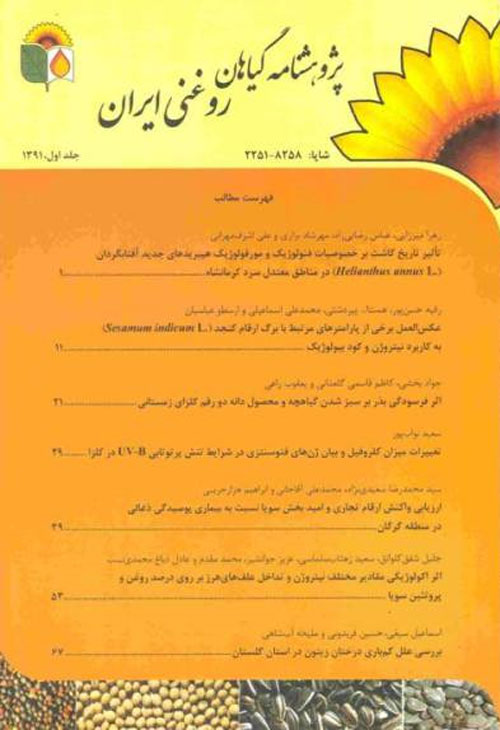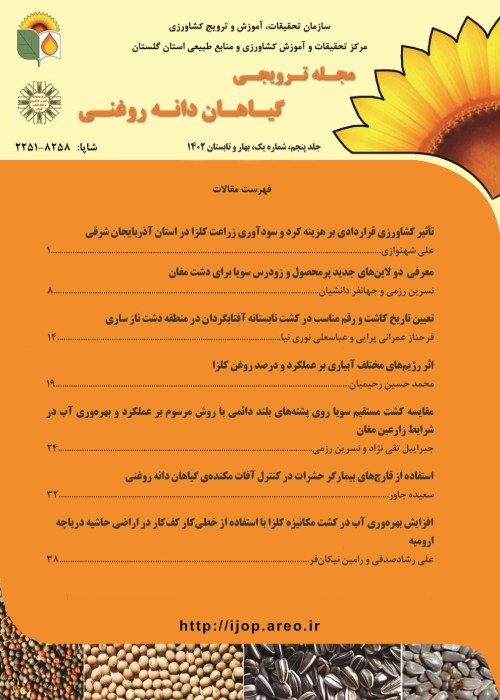فهرست مطالب

نشریه گیاهان دانه روغنی
شماره 1 (1391)
- تاریخ انتشار: 1391/06/20
- تعداد عناوین: 7
-
Page 1Sunflower (Helianthus annus L.) is the fourth most important oil crop in the world and Sunflower oil has high quality because of its high content of unsaturated fatty acids. In order to study the sunflower for second cropping and the effect of planting dates on phenological and morphological traits of new hybrids of sunflower a split plot experiment based on a randomized complete block design with 3 replications was carried out at the Islamabad Research Station, Iran in 2010. Three planting dates, 10th of June, 26th of June and 11th of July were main plots and sunflower hybrids, CMS 19×R43 (Azargol), Allstar, SHF-81-85 (Farokh), and SHF-81-90, were used as sub-plots. Effect of planting date on days to star-like stage, days to complete flowering, days to physiological maturity, GDD at all phenological stages, head diameter, plant height, thousand seed weight, seed yield were significantly different (P<0.01, P<0.05) Planting on 10th of June and 11th of July produced the highest (4244.7 kg ha-1) and lowest (2978 kg ha-1) yield,respectively. The results showed that the cultivars CMS 19×R43 and SHF-81-90 should be used for planting before early July and, the cultivates All star and SHF-81-85 for planting after early July.Keywords: Flowering date, Physiological Maturity, Planting date, Sunflower
-
Page 11In order to analyze some leaf physiological parameters of Sesame cultivars under the influence of bio fertilizer and nitrogen applications an experiment was arranged in a split-split plot based on a randomized complete block design with three replications under filed conditions. Nitrogen fertilizers (0, 60, 90 and 120 kg ha-1) were as main plots and Supernitroplus bio fertilizer as sub-plots (with and without bio fertilizer) and Sesame cultivars (Naz, Oltan and Varamin 2822) in sub sub-plots. The maximum leaf dry weight, stem dry weight and leaf area were recorded for Varamin cultivar while Varamin and Oltan cultivars did not have any significant differences for leaf dry weight to stem ratio. Oltan cultivar had the lowest specific leaf area that indicates more efficient photosynthetic system. Application of bio fertilizer significantly enhanced the leaf dry weight. Significant interaction between cultivar and nitrogen for the indices under study showed that higher levels of nitrogen (90 and 120 kg N ha-1) in Oltan and Naz cultivars vs. Varamin cultivar caused a more favorable growth index. Therefore, it might be concluded that production of extra leaf in Varamin cultivar is not a superiority parameter for photosynthesis, thus changes in this parameters with nitrogen and bio fertilizer could ensure optimum yield.Keywords: Bio fertilizer, Leaf area ratio, Sesame cultivars, Specific leaf area
-
Page 21
The effect of seed deterioration on seed emergence and seed yield of two oilseed rape cultivars (Licord and Okapi) was investigated in a factorial experimentation based on an RCB design with 3 replications in 2008 at the Research Farm of the Tabriz University, Iran. A sub-sample of seeds of each cultivar was kept as control (V1 with 98% viability) and two other sub-samples of Licord and Okapi with about 15.5% moisture content were artificially deteriorated at 40°C for 9 and 12 days, and for 7 and 10 days, respectively, (V2 and V3 with 85% and 71% viabilities, respectively). The highest percentage of seedlingemergence was obtained for the high quality seed lot and decreased with decreasing seed lot viability. Although grain yield per plant for plants from deteriorated seed lots (V2 and V3) were higher than those from high-viability seed lot (V1), but these advantages in individual plant performance were not sufficient to compensate for low stand establishment as indicated by 26.18% and 49.75% loss in grain yield per unit area for plants from V2 and V3 seed lots, respectively. Consequently, grain yield per unit area significantly improved with increasing seed vigor and viability of oil seed rape cultivar.
Keywords: Grain yield, Oilseed rape, Seed deterioration, Seed vigour, Seedling emergence -
Page 29The depletion of stratospheric ozone layer causes increase in ultra violet radiation incidence on earth. Basically, plant species show different response to UV radiation. This research was carried out because of the importance of photosynthetic gene expression and simultaneous study of relative chlorophyll loss rate under UV-B radiation condition. Seed of Brassica napus cv. Bristol was planted in light filler and vernalized at 4 c, then transferred into the research greenhouse. The study was carried out in a completely randomize design with 4 UV-B treatments and 4 replicates. Leaf samples were taken at the maximum vegetative growth stage (beginning of flowering). RNA was extracted and blotted onto nylon membrane. Northern hybridization was then done by using radioactive probes of photosynthetic gene clones RBCS, Lhc2, cab and antioxidant gene (Thio) and gene expression pattern was investigated. Also, chlorophyll a and b content and cellular oxidative index (TBARM) were measured under UV-B radiation. Chlorophyll a content showed linear decrease with increase in UV-B intensity. Whereas, chlorophyll b was more stable especially at more intensified UV-B (every two-day) treatment. This was relevant to consistency of Lhc2 expression under UV-B radiation. The decrease of RBCS gene expression was more than that of Lhc2 and cab. It shows the higher sensitivity of this gene to increased reactive oxygen species. The amount of TBARM and gene expression of Thio showed considerable increase with increase in UV-B radiation period.Keywords: Brassica napus, Chlorophyll, Photosynthetic gene, UV
-
Page 39
Charcoal rot, caused by Macrophomina phaseolina, is one of the most important fungal diseases of soybean that causes reduction in quantity and quality of the production. This research was performed to investigate resistance of 66 promising and commercial genotypes of soybean (from three maturity groups of early, middle and late mature groups) to the disease at the agricultural research station of Gorgan in a randomized complete blocks design with three replications. The existence of microsclerotia in the root and stem was considered as a criterion for distinguishing infected plants from healthy ones, and disease incidence (I) and severity (S) was measured at growth stage of R7. At the end of the growing season yield and its components were measured. The results of ANOVA showed that there was a significant difference (P<0/01) for disease intensity among genotypes. The comparison of data mean showed that line DI41 (with I= 100% and S=100 %) was the most susceptible and line Sepideh * T1SRF (10) (with I= 0 and S=13.3%) was the most resistant genotype against charcoal rot. The evaluation of the disease based on maturity groups revealed that early maturing group (III) had more infection and fewer yields and late maturing group (V) had less infection and higher yield. There was significant relationship among the intensity of infection, yield and yield components.
Keywords: charcoal rot, Macrophomina phaseolina, Maturity groups, Resistance, Soybean genotypes -
Page 53
Ecological effects of different nitrogen rates and weed interference on oil and protein percentage of soybean was studied in a two-year experiment at the Agricultural Research Station of Tabriz University, Iran. In each year, experiment was carried out as split-plot based on a randomized complete block design with three replications. Four nitrogen levels (0, 20, 40 and 60kgN/ha) were the main plots and 10 weed interference periods (two sets) were the subplots. In the first set, the plots were kept weed-free initially until VE (emergence of cotyledons), V1 (1st trifoliate), V4 (4th trifoliate), R1 (beginning bloom) and R3 (beginning pod) growth stages (GS) by hand. In the second set, plots were left weed infested initially for the corresponding periods and subsequently kept weed free. Results of analysis of variance showed that in the first year, protein and oil percent were significantly affected by different levels of nitrogen and period of weed interference. However, in the second year of testing and combined analysis of the two years, protein and oil percentage were not affected significantly by different levels of nitrogen and period of weed interference. In general, protein was reduced with increase in duration of weed contamination. When weed interference duration increased, oil percentage of soybean seed increased. Soybeen seed in weedy control had 5.71% less protein than full season weed-free control treatment. The increase in the nitrogen levels enhanced soybean tolerance to the presence of weeds. Although, vegetative phase was shortened, the growth and grain yield were increased by nitrogen application. The reductions in nitrogen use may warrant more intensive weed management. Furthermore, reductions in the nitrogen level before soybean planting may cause the need for more immediate weed control and for longer times.
Keywords: Nitrogen, Oil, Protein, Soybean, Weed competition, Weed interfere -
Page 67
Olive is one of the oldest fruit trees producing one of the healthiest edible oil. In some areas, olive trees do not produce high yield. In this project, the low productivity of olive trees in Golestan province was investigated. Fifteen commercial olive orchards were checked during flowering and some characteristics of flowers and self-incompatibility were studied in few trees. The results showed that there were highly significant differences between the orchards, trees and flowering shoots in the number of flowers per inflorescence and the percent of perfect flowers (P = 0.001 in both). Gordal Sevilana and Zard cultivar had the lowest (4.4%) and highest (44.86%) percent of perfect flowers, respectively. The results also showed that Zard-e-golooleh and Gordal Sevilana were completely self-incompatible and Zard, Mission and Koroneiki were partially self-compatible. According to this study, the low productivity of the olive trees in this area had different reasons. Juvenility, vegetative adult phase and alternate bearing are theproblems in the low flowering trees, but the main problem is the unadaptability of some cultivars like Zard and Roughani-e-roodbar to the climatic conditions of the area. On the other hand, a few trees produced considerable number of flowers but had low productivity. In some of them, most of the flowers were staminate. The others had pollen self- and cross-incompatibility and in some areas successful pollination did not occur due to unsuitable climatic conditions during anthesis. The best solution for such problems is selecting the suitable cultivars for the area and grafting them on the low producing trees as top working.
Keywords: Flower, traits, Olea europaea L., pollen, incompatibility, Self, incompatible


